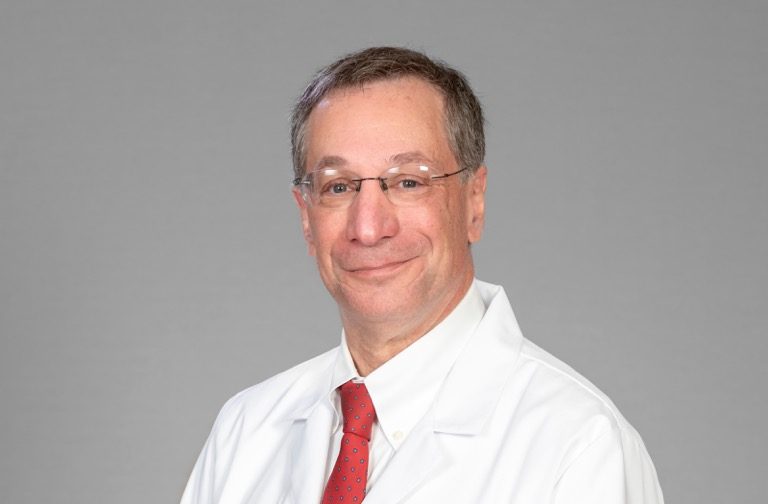Ari Namon’s interest in medicine “was gradual,” he says. In fact, the Ear, Nose and Throat (ENT) doctor, who joined the Charlotte Hungerford Hospital (CHH) staff earlier this year, initially planned to pursue research. “I in part went to med school because I thought I would do better getting grants if I was an MD/PhD,” he admits. “But I enjoyed the clinical part of medical school too much.”
Dr. Namon says he felt an immediate affinity toward surgery and found otolaryngology to be the most interesting and challenging of the surgical specialties. “There’s a lot of high-priced real estate in a small area in the head and neck,” he explains.
During his training, he especially loved treating – and taking care of – head and neck cancer patients. So he pursued a fellowship in skull-based and reconstructive surgery, learning to diagnose and treat cancers that occur in the head and neck, and to perform reconstruction when necessary. His fellowship training also focused on treating victims of trauma like burns, motor vehicle accidents, and domestic abuse. “There are some pretty awful injuries,” he says, “but putting patients back together is challenging and rewarding at the same time.”
Closer to home
Dr. Namon was born in northern New Jersey and attended Rutgers New Jersey Medical School. He interned at Hahnemann University Hospital in Philadelphia, completed his ENT residency at University of Chicago Medical Center, and did his head and neck fellowship training at Rush-Presbyterian-St. Luke’s Medical Center (now Rush University Medical Center), also in Chicago.
Before coming to CHH, Dr. Namon ran an ENT practice for many years in Sharon, Connecticut, and later served as director of head and neck surgery at CareMount Medical in Poughkeepsie, New York. He also devoted time to performing cosmetic procedures like face-lifts, blepharoplasty, and laser resurfacing at Sono Bello in New York City, and recently became board certified in facial plastic and reconstructive surgery (he was already board certified in otolaryngology-head and neck surgery).
Joining the CHH staff in February brought Dr. Namon closer to home (he and his family live in Lakeville, Connecticut), and gave him the opportunity to see some of his former Sharon patients. “Now I’m taking care of the children of people I took care of when they were children,” he says.
A broad specialty
At CHH, Dr. Namon continues to focus on head and neck cancer, cosmetic and reconstructive surgery, and nasal and sinus disease – all areas of expertise. “But I also do general ENT because we are a community hospital and there is the need,” he says. ENT is a broad specialty, notes Dr. Namon: He treats conditions ranging from tonsillitis to hearing loss to tumors of the larynx, throat, lips, mouth, nose, and salivary glands.
Many of his patients suffer from sinus disease; in fact, sinusitis – or inflammation of the sinuses – is one of the most commonly diagnosed infections in the United States, according to the National Institutes of Health, affecting about 15 percent of adults each year. Most of the sinus patients Dr. Namon sees have failed to improve with over-the-counter medication or antibiotics prescribed by their primary care practitioners. “We’ll try medical management if it hasn’t been tried already,” he says, “but if someone has four or five sinus infections per year requiring antibiotics, and a CT scan and nasal endoscopy I do in the office confirms sinus disease, sinus surgery is a good option.”
Dr. Namon has performed well over 1,000 sinus surgeries over the course of his career. “I trained at just the right time for sinus surgery, just as endoscopic surgery [surgery through a fiber-optic scope inserted in the nose] was beginning to be taught. I actually presented one of the first complications of endoscopic sinus surgery at one of the American Academy of Otolaryngology-Head and Neck Surgery annual meetings back when I was in Chicago, and was co-director of a continuing education course for surgeons in which sinus surgery was a major component.”
Dr. Namon takes the minimally invasive approach to sinus surgery that is now the standard of care, using endoscopic sinus surgery to remove polyps and open up the sinuses to improve ventilation, or, in less severe cases, balloon sinuplasty, in which a balloon is introduced through the nostril and then inflated to expand the sinus cavity.
He is looking forward to the arrival of a new navigation device at CHH that enables surgeons to view in real time, on a monitor, the inside of the sinus cavities as they operate. The device also shows surgeons – simultaneously on three different screens – a CT scan of the area and the exact location of the surgical instruments. The increased precision is particularly useful in sinus surgery: “Sinuses sit underneath the brain and between the eyes, so you have to be really careful,” notes Dr. Namon.
Tackling head and neck cancer: An increasing threat
Head and neck cancer is a broad term encompassing tumors of the mouth, throat, voice box, and glands in the head and neck (i.e. thyroid). While head and neck cancers account for only about 4 percent of cancers in the U.S., incidence is on the rise, and in an increasingly younger patient population.
“What’s interesting is that the increase is due to Human Papillomavirus (HPV),” notes Dr. Namon. “Head and neck cancer used to be almost exclusively related to smoking, and secondarily to drinking, but I’ve actually seen more HPV-related cancers than smoking-related cancers in the last five years.” The incidence of HPV-related head and neck cancer, in fact, has even surpassed that of HPV-related cervical cancer.
While HPV-related oral cancers are more easily cured, Dr. Namon says, patients who have HPV may not just get the one cancer. “As opposed to those who get smoking-related cancers, quit smoking, and lower their cancer risk, if you have HPV, you still have HPV even after we treat the cancer.” Because there is currently no cure for HPV, Dr. Namon says, the HPV vaccine is extremely important. “Stop smoking, have safe sex, and get vaccinated,” says Dr. Namon. “That will prevent 90 percent of head and neck cancers.”
According to Dr. Namon, there is a whole bag of tricks in facial plastic surgery – including flaps, grafts, and other techniques – for aesthetically closing the defects that result from the removal of skin and other facial cancers. “But when someone has cancer, first we want to cure the cancer, second, we want to reestablish function, and then third, we want to reestablish natural appearance,” Dr. Namon explains.
Dr. Namon recalls a recent case in which he removed a nasal lesion from a patient. The lesion started on the inside of the nostril and wrapped around the outside of the nose. “We had to worry about cosmetics, obviously, but first we had to make sure that he could breathe,” says Dr. Namon. He described a four-stage reconstruction, in which he borrowed mucous membrane from the septum to repair the damaged lining in the nose, cartilage from the ear to reconstruct the structure and support of the nostril, and skin from the laugh lines to resurface the outside of the nose.
“I love doing that stuff – I could do it all day long,” says Dr. Namon. “Curing patients’ cancer and giving them the best possible appearance is challenging and incredibly rewarding.”
Lori Miller Kase is a freelance writer living in Simsbury.
Photography courtesy of Charlotte Hungerford Hospital








More Stories
Jamie Shawver, D.O.: The Modern-Day Family Doctor
Leading in Urologic Oncology: Ryan Dorin, M.D., Works on Expanding Patient Care
UConn Health Stands at the Forefront of Comprehensive Sickle Cell Treatment in the U.S.